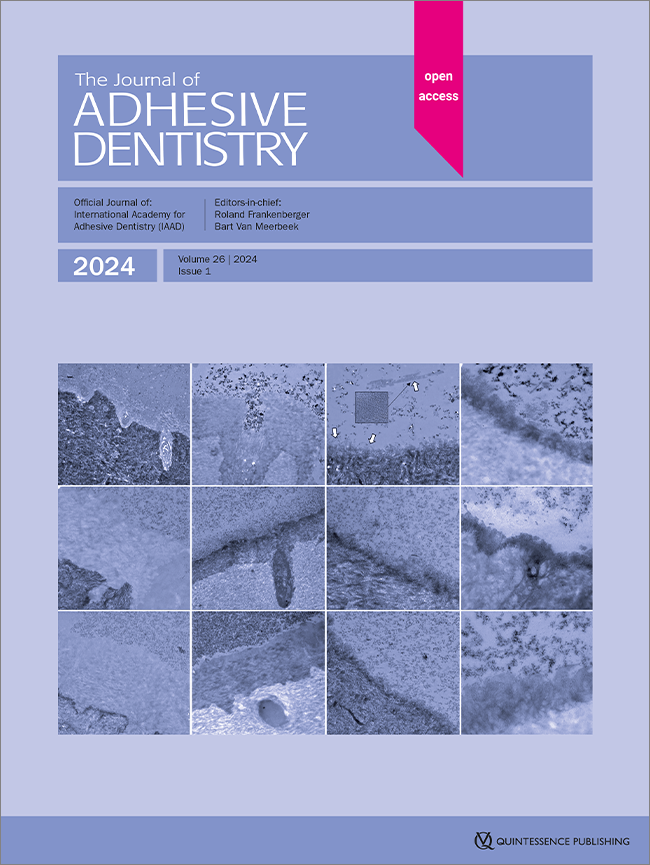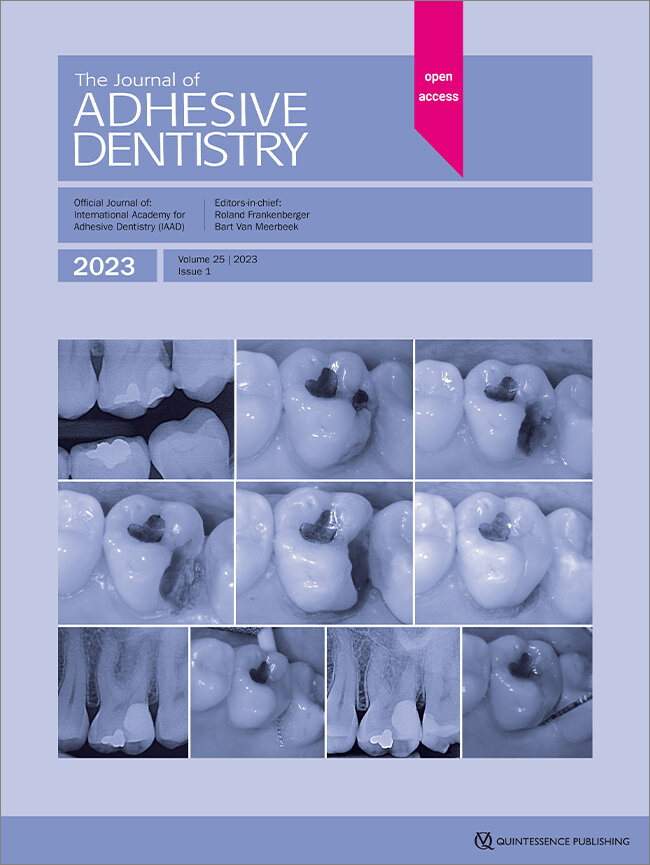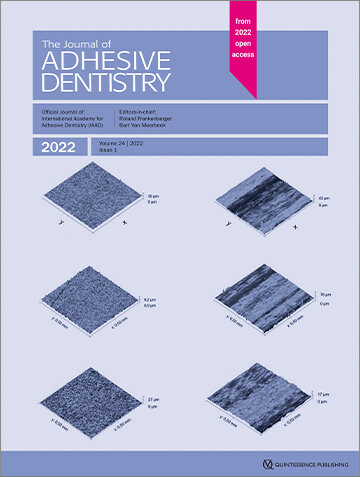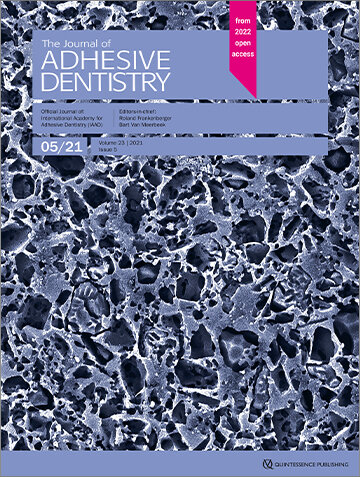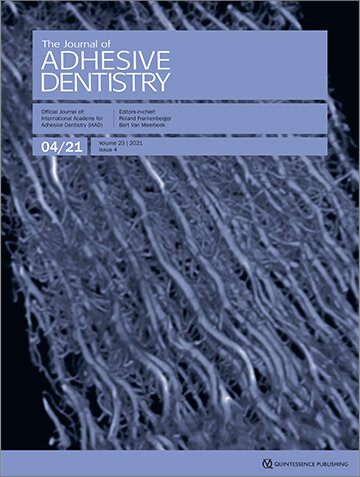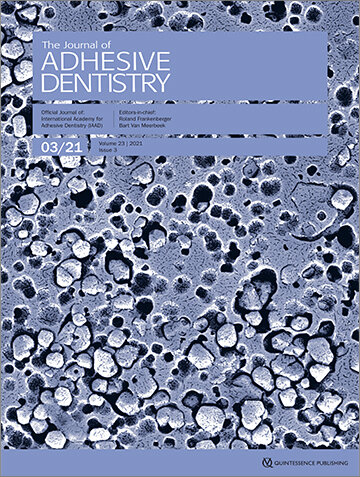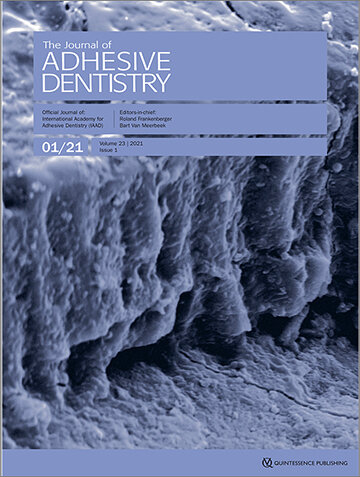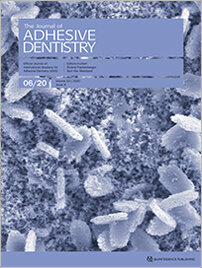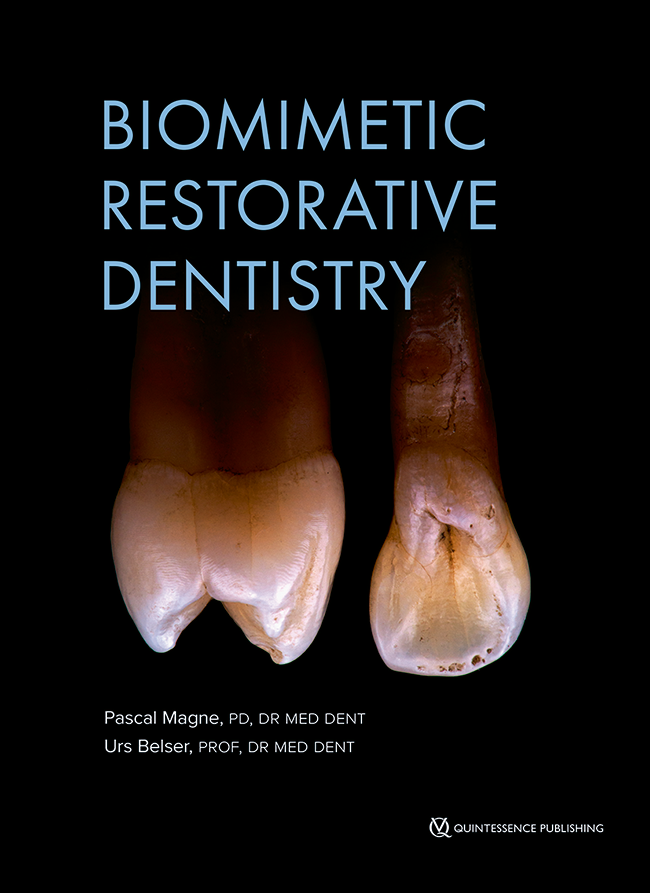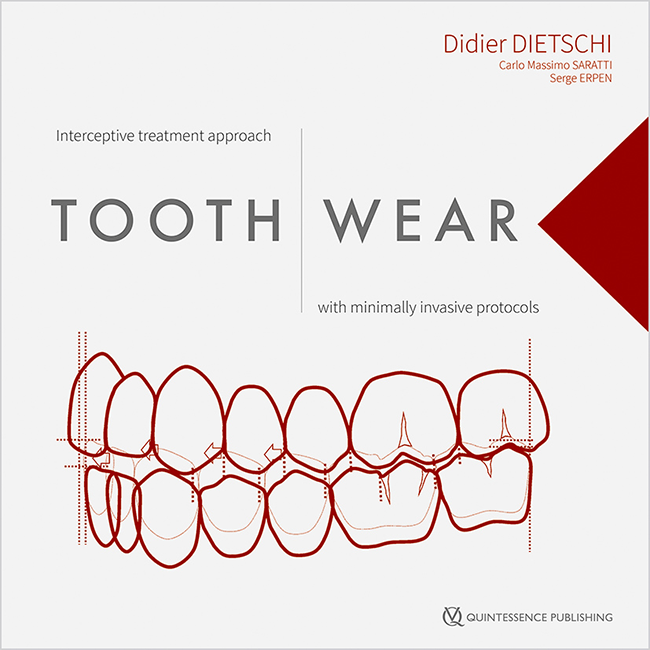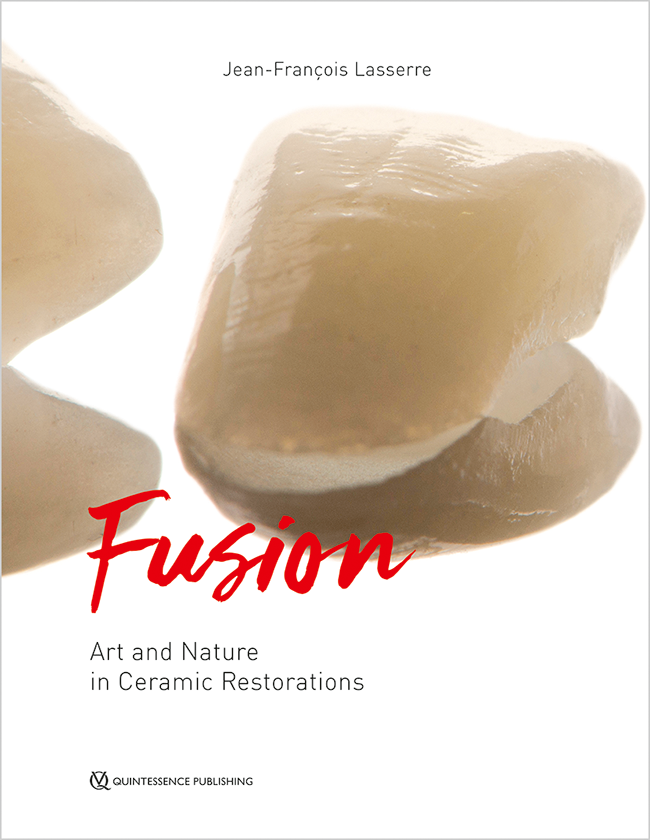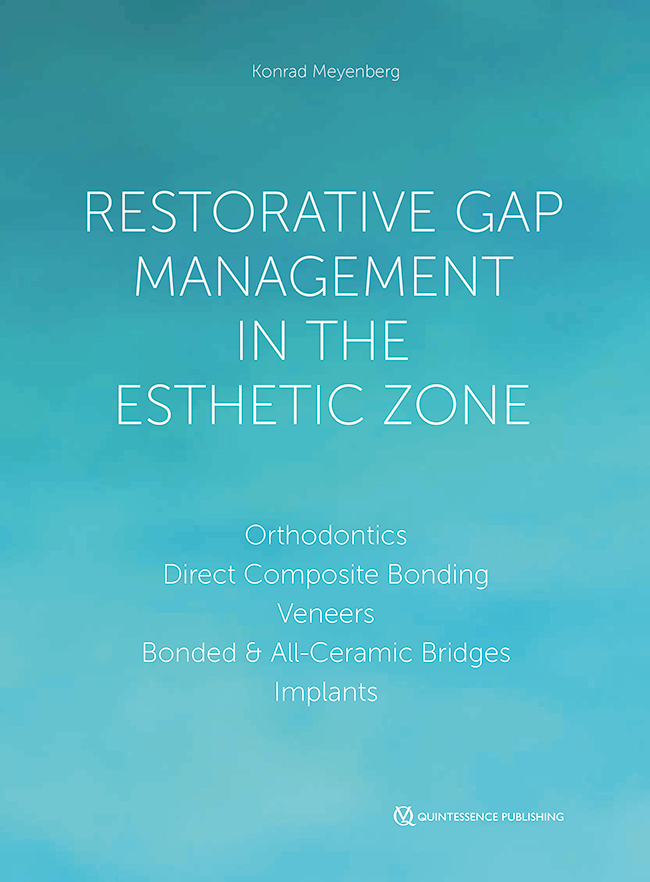Open Access Online OnlyClinical ResearchDOI: 10.3290/j.jad.c_1854, PubMed ID (PMID): 39903473February 4, 2025,Pages 1-7, Language: EnglishSrichai, Sutasinee / Saikaew, Pipop / Sattabanasuk, Vanthana / Senawongse, PisolObjective: To evaluate the effect of pre-procedural antiseptic mouthwashes on dentin bond strength of different adhesive systems. Methods: Flat occlusal dentin surfaces from 120 extracted human molars were randomly divided into four groups according to mouthwashes (0.12% chlorhexidine = CHX, 1% hydrogen peroxide = HP, 0.2% povidone-iodine = PI, and no mouthwash/control) and three subgroups of adhesives used (Clearfil SE Bond; CSE, Single Bond Universal = SBU in etch-and-rinse (ER) or self-etch (SE) modes) (n = 8). Composite resin was built up, and all bonded teeth were stored in 37°C distilled water for 24 h. Stick-shaped specimens were prepared and subjected to microtensile bond strength (µTBS) test. Failure mode analysis was determined using a light microscope. A resin-dentin interface was observed using scanning electron microscopy (SEM, n = 2). Elemental analysis in the PI group was further examined by SEM with energy-dispersive X-ray spectroscopy. The µTBS data were statistically analyzed by two-way analysis of variance (ANOVA) and Duncan’s multiple comparison (P < 0.05). Results: Rinsing with PI followed by SBU-SE demonstrated significantly higher µTBS than the control group (P < 0.05). Rinsing with HP showed significantly lower bond strength for CSE (P < 0.05). However, the effect of adhesive systems was not observed for all mouthwashes used (P > 0.05). SEM/EDX revealed the iodine deposition in the underlying dentin, where the highest amount of iodine was found for SBU-SE. Conclusion: CHX and PI can be recommended as pre-procedural antiseptic mouthwashes since they show no negative impact on µTBS for all tested adhesives. The dentin bond strength of CSE is hampered in the HP mouthwash group, and this should be a concern for the use of self-etching adhesive afterward.
Keywords: adhesion to dentin, adhesive, dentin, microtensile bond strength, pre-procedural antiseptic mouthwash
Open Access Online OnlyClinical ResearchDOI: 10.3290/j.jad.c_1865, PubMed ID (PMID): 39918418February 7, 2025,Pages 9-19, Language: EnglishHofmann, Maria / Wolf, Emma / Lücker, Susanne / Frankenberger, Roland / Wöstmann, Bernd / Krämer, NorbertPurpose: The aim of this study was to evaluate the marginal quality and wear of bulk-fill composite resins (BFs) for Class-II restorations of primary and permanent molars in comparison to a conventionally layered composite resin (RC) and to compare the results of the two dentitions. Materials and Methods: Eighty (40 primary and 40 permanent) extracted molars received standardized Class-II cavity preparations and were restored with either one of two flowable BFs, one of two high viscous BFs, or a composite resin (RC). Thermomechanical loading (TML; 2,500 cycles +5°C/+55°C; 100,000 cycles, 50N, 1.67Hz) followed. A quantitative marginal analysis using SEM images and a profilometric quantification of two-body wear were carried out using replicas. ANOVA, Kruskal–Wallis, Mann–Whitney U, and Wilcoxon signed-rank tests were used for statistical analysis (P < 0.05). Results: For both dentitions, a significant reduction of perfect margins was observed after TML (P < 0.02). For the primary dentition, the flowable BFs showed significantly less perfect margins than all high viscous materials (P < 0.005). For the permanent dentition, RC showed significantly fewer gaps than the flowable BFs (P < 0.04). Regarding wear, within the dentitions, no significant differences could be computed between groups with regard to the maximum height loss (P < 0.05). Conclusion: All of the investigated bulk-fill composite resins showed satisfactory in-vitro results for both tested parameters in primary and permanent teeth, with a superiority of the high-viscosity materials in terms of marginal quality.
Keywords: bulk-fill composite resins, marginal quality, permanent teeth, primary teeth, restoration materials, wear
Open Access Online OnlyCLINICAL MEDICINEDOI: 10.3290/j.jad.c_1871, PubMed ID (PMID): 40063077March 10, 2025,Pages 21-29, Language: EnglishReymann, Josephine / Narayanan Ramakrishnan, Anantha / Ludtka, Christopher / Hey, Jeremias / Kiesow, Andreas / Schwan, StefanPurpose: The current trend in denture adhesives is shifting toward zinc-free formulations due to the significant health concerns associated with zinc. Studies have focused on the retention of these zinc-free denture adhesives; however, there is a dearth of literature regarding their damping performance. This study analyzes the impact of oral cavity physiological parameters: temperature, pH, and swelling ratio on the mechanical properties of zinc-stabilized and zinc-free denture adhesives and examines the role zinc plays in influencing the adhesive behavior. This study investigates how underlying mechanical properties of adhesive cream change for zinc-stabilized and zinc-free denture adhesives. The relative damping and its variation from exposure to physiological conditions in the oral cavity can significantly assist in the design of dentures to reduce the discomfort experienced by denture wearers. Materials and Methods: The relative damping of the zinc-stabilized and zinc-free denture adhesives was investigated with the loss modulus values, which were evaluated using rheological frequency sweep tests. The tests were performed by maintaining the denture adhesives at specified values of temperature, pH, and swelling ratio, and over a frequency range of 0.01 Hz to 10 Hz, which included the average frequencies of human chewing / bite forces reported in existing literature. Results: Zinc-stabilized denture adhesive showed a larger fluctuation of loss modulus values compared to the zinc-free formulation with respect to pH, temperature, and swelling ratios. The zinc-free denture adhesive showed higher damping behavior at frequencies below 0.7 Hz, whereas the zinc-stabilized denture adhesive showed higher damping behavior above loading frequencies of 0.7–1 Hz. Both the adhesives showed varying behavior on either side of the bite force spectrum in terms of relative damping of the applied bite. Conclusions: The damping or cushioning effect provided by denture adhesives can reduce pain experienced and assist dental practitioners in better supporting denture wearers.
Keywords: bite force, damping, denture retention, physiological parameters, zinc-free denture adhesive
Open Access Online OnlyResearchDOI: 10.3290/j.jad.c_1951, PubMed ID (PMID): 40178407April 3, 2025,Pages 31-42, Language: EnglishCarvalho, Thiago Saads / Baumann, Tommy / Said Zayed, Mohamed Ahmed / Loguercio, Alessandro D. / Peutzfeldt, Anne / Niemeyer, Samira HelenaPurpose: To modify phosphoric acid (PA) with polyphenol-rich plant extracts and verify their effect on immediate (24 h) and long-term (1 year) micro-shear bond strength (µSBS) of an adhesive system to sound and eroded dentin. Materials and Methods: 420 dentin specimens (360 for µSBS and 60 for characterization) were prepared and divided into two substrate-subgroups: sound (untreated) and eroded dentin (underwent 10 cycles of 1 h exposure to human saliva and 5 min immersion in citric acid). The specimens from each subgroup were randomly distributed into six groups, according to PA (n = 30/group): PA-EXP (experimental control), PA-GSE (PA-EXP + grape seed extract), PA-BLU (PA-EXP + blueberry extract), PA-CRA (PA-EXP + cranberry extract), PA-GRE (PA-EXP + green tea extract), PA-COM (commercial control). After etching with the respective PA (15 s), specimens were restored with adhesive and composite resin. Half of the specimens of each group were subjected to µSBS testing after 24 h and the other half after 1 year of storage (tap water, 37°C). Analyses were made with three-way ANOVA and post-hoc Tukey tests (α = 0.05). Results: Higher µSBS was observed to sound dentin than to eroded dentin, regardless of the storage time, except for PA-BLU and PA-GSE after 1 year (p = 0.40 and p = 0.10, respectively). After 24 h, for both substrates, PA-COM presented statistically significantly lower µSBS than the other PAs. After 1 year, µSBS was significantly reduced for all groups except for the PA-COM (sound: p = 0.67; eroded: p = 0.13). Conclusion: Compared to the commercial PA, the modified PAs improved the immediate µSBS and gave similar long-term µSBS to sound as well to eroded dentin.
Keywords: bond strength, cross-linkers, dental restoration, phosphoric acid, polyphenol, longevity, surface characterization
Open Access Online OnlyClinical ResearchDOI: 10.3290/j.jad.c_1953, PubMed ID (PMID): 40178408April 3, 2025,Pages 43-51, Language: EnglishPiemjai, Morakot / Lerttriphob, Thanyarat / Jariyapayuklert, Carat / Garcia-Godoy, FranklinPurpose: To investigate the dye penetration distance at Class V tooth-restoration margins/interfaces prepared in the labora-tory and orally using a primerless wet technique and MMA-TBB bonding resin with or without 4-META monomer promoter. Materials and Methods: A box-form cavity at the cementoenamel junction was prepared on extracted human premolars and vital teeth scheduled for extraction for in-vitro and in-vivo studies, respectively. For each vital cavity, 1% citric acid and 1% ferric chloride aqueous (1-1) conditioner was applied for 10 s, 30 s, or 60 s, rinsed off and blot-dried, and was then bonded with either 4-META/MMA-TBB or MMA-TBB resin and bulk-filled with light-cured composite resin (n = 10). Restored vital teeth continued to function in the oral cavity for seven days before extraction. Restorations were stored in water at 37°C and 0.5% basic fuchsin dye solution for 24 h each before dye penetration measurement under a microscope, while a hybrid layer was observed using a scanning electron microscope (SEM). Results: No hypersensitivity or pain occurred in any vital teeth. For all 1-1 groups, no dye penetration was detected at any margins of the in- vitro restorations. Dye penetration (0.13 mm) was only observed in one intraoral restoration of 60 s etching with MMA-TBB resin at the cementum/dentin margin. A consistent hybrid layer after chemical modification was observed in leakage-free specimens. Conclusion: The results suggest that the 1–3 µm 1-1 demineralized substrate clinically provides sufficient permeability to form a microleakage-free hybrid layer using a primerless wet technique with MMA-TBB or 4-META/MMA-TBB resin. Intraoral microleakage-free restorations may lead to longer-term restored-tooth survival.
Keywords: intraoral microleakage-free restoration, MMA-TBB resin, primerless wet technique, 4-META/MMA-TBB resin, hybrid layer, tooth hypersensitivity
Open Access Online OnlyClinical ResearchDOI: 10.3290/j.jad.c_1988, PubMed ID (PMID): 40237152April 16, 2025,Pages 53-64, Language: EnglishJanson, Malin / Bassier, Vanessa / Liebermann, Anja / Schoppmeier, Christoph Matthias / Gregorio-Schininà, Maria DiPurpose: This in-vitro study evaluated the effect of universal adhesives and sandblasting with 50 μm and 110 μm aluminum oxide particles (Al2O3) on the shear bond strength (SBS) between composite and zirconia in repair applications across different aging intervals. Materials and Methods: 1296 zirconia specimens (Katana Zirconia HT) were randomized into three main groups: (A) sandblasting with 50 μm Al2O3, (B) sandblasting with 110 μm Al2O3, and (C) control. Each group was further divided into six subgroups: OPB (Optibond Universal), PBA (Prime&Bond Active), IBU (iBond Universal), CUBQ (Clearfil Universal Bond Quick), MBP (Monobond Plus), and SBUP (Scotchbond Universal Plus). Composite (Clearfil Majesty ES-2 Universal) was applied, and SBS (MPa) measured at baseline (24-h storage) at 30 and 90 days, and after 7 days + 5000 thermocycles (5–55°C). Failure modes were assessed at 40 × magnification. Analysis used a generalized linear model (GLM) with Bonferroni adjustment (α 0.05). Results: Sandblasting significantly increased SBS compared to controls, with Group B showing the highest durability after thermocycling, with values decreasing over aging periods. In Groups A and B IBU (21.43 ± 2.7 MPa; 25.60 ± 5.78 MPa), SBUP (19.26 ± 3.2 MPa; 23.62 ± 4.4 MPa), and CUBQ (19.92 ± 2.8 MPa; 22.75 ± 4.34 MPa) achieved the highest SBS, with adhesive failures being predominant and cohesive failures mainly in high-SBS subgroups. Conclusion: Pretreatment with Al2O3 significantly enhances composite-zirconia bond strength, with larger grit sizes more effective. MDP-containing adhesives are recommended for reliable zirconia repairs.
Keywords: repair, shear bond strength, universal adhesives, zirconia
Open Access Online OnlyCLINICAL MEDICINEDOI: 10.3290/j.jad.c_1966, PubMed ID (PMID): 40237153April 16, 2025,Pages 65-74, Language: EnglishEtiennot, Line / Ordies, Michiel / Yao, Chenmin / Mercelis, Ben / Peumans, Marleen / Van Meerbeek, BartPurpose: The study aimed to measure the efficacy of 10-methacryloyloxydecyl dihydrogen phosphate (10-MDP) saliva-decontamination protocols by measuring bonding effectiveness to saliva-contaminated dentin following different surface-decontamination protocols. Materials and Methods: The micro-tensile bond strength (µTBS) of the two-step self-etch (SE) adhesive Clearfil SE Bond 2 (‘CSE2’, Kuraray Noritake) and the one-step SE adhesive Clearfil Universal Bond Quick (‘CUBQ’, Kuraray Noritake) to saliva-contaminated bur-cut dentin was measured when saliva-contaminated dentin was decontaminated by either the 10-MDP-containing Katana Cleaner (‘KC’, Kuraray Noritake) or CSE2 primer (‘CSE2p’), with bonding to saliva-contaminated (‘saliva(–)’) and non-contaminated dentin (‘clean(+)’) having served as negative and positive control, respectively. Half of the specimens were subjected to µTBS testing ‘immediately’ after 1-week water storage, while the other ‘aged’ half was tested after 50,000 thermocycles. Statistics involved linear mixed modeling (LMM) with restricted maximum likelihood (REML) estimation (α = 0.05). Results: Overall, the two-step SE adhesive CSE2 outperformed the one-step SE adhesive CUBQ. Saliva-contaminated dentin was most effectively decontaminated when CSE2p was applied with both adhesives, closely followed by KC decontamination. Notably, CSE2 demonstrated satisfactory performance even without separate decontamination. Conclusion: Unaltered bonding to saliva-contaminated dentin was achieved upon surface decontamination with CSE2p and KC. Using CUBQ, additional decontamination with either CSE2p or KC is strongly recommended. In the case of CSE2, no additional decontamination agent is required.
Keywords: adhesive, bond strength, decontamination, Katana Cleaner, saliva
Open Access Online OnlyCLINICAL MEDICINEDOI: 10.3290/j.jad.c_1980April 30, 2025,Pages 75-80, Language: EnglishKrempels, Jacqueline Victoria / Sturm, Richard / Neumann, Konrad / Schumacher, Tamara / Schouten, Christian / Faber, Franz-Josef / Frankenberger, Roland / Roggendorf, Matthias JohannesPurpose: To investigate the effect of tooth age on dentin adhesion of different luting systems to the root canal.
Materials and Methods: 180 root canals of extracted teeth were divided into three age-specific groups (n = 60): young 20–35 (y), middle-aged 45–60 (m), and older 70–85 (o) years. Ten teeth of each age group were assigned to a luting system: Panavia 21 with ED Primer (P21, Kuraray); Core X Flow with Prime&Bond active and Self-Cure Activator (CXF, Dentsply Sirona); Multilink Automix with Multilink Primer (ML, Ivoclar Vivadent); Panavia SA Cement Plus (PSA, Kuraray); Smart Cem 2 (SM2, Dentsply Sirona); Speed CEM Plus (SCP, Ivoclar Vivadent).
The root canals of decoronated teeth were instrumented with F360 (Komet) and BR7 (FKG) up to a working length of 8 mm (Ø0.6mm, taper 0.02) and filled with standardized steel spreaders and the selected material. The intracanal bond was determined by a pull-out test. The failure modes were categorized as an adhesive to dentin (AD), adhesive to spreader (AS), cohesive within the composite (C), and mixed (M). Statistical analysis was performed using non-parametric ANOVA, Tukey, and Chi-square test at a significance level of α ≤ 0.05.
Results: The study showed significant differences for the various luting systems (ANOVA, P 0.05). PSA showed significant differences in bond strength to SM2, CXF, SCP, and ML, as did SM2 to P21 and SCP (Tukey, P 0.05). M (46%) occurred 53% in y and 70% in SCP.
Conclusions: No adhesive strategy can yet be recommended for tooth age. Clinically available luting systems show significant differences in their adhesion values.
Keywords: luting systems, post adhesion, root canal dentin, tooth age
Open Access Online OnlyResearchDOI: 10.3290/j.jad.c_1991April 30, 2025,Pages 81-91, Language: EnglishSturm, Richard / Shemesh, Hagay / Bortel, Emely / Hesse, Bernhard / Bitter, KerstinPurpose: Evaluation of different composites with varying viscosity for their suitability as intracanal anchorage (ICA) materials using push-out bond strength testing.
Materials and Methods: 48 human maxillary incisors were root filled, crowns partially removed except one residual wall, and distributed into four groups (n = 12), according to one of the following ICA composites: Ormocer (AFx), preheated composite (VB), core build-up (RDC) or flowable (SDR). A 4 mm deep root canal enlargement was prepared using Gates Glidden burrs, and hard tissues were conditioned using a universal adhesive in etch-and-rinse mode. Intracanal cavities were filled using the groups’ specific ICA material and a nanohybrid composite (GrandioSO, VOCO) for crown reconstruction. Two samples per group were scanned using phase-contrast-enhanced µ-computer tomography (PCE-CT). The remaining samples were thermo-mechanically loaded (TML), and push-out bond strengths and fracture patterns of ICA materials were analyzed.
Results: Push-out bond strengths were significantly affected by ICA materials (P = 0.001) and location inside the root canal (P 0.005; generalized estimating equations). VB showed a significantly lower bond strength (13.5MPa ± 5.3MPa) compared to RDC (19.6MPa ±7.6MPa) and AFx (21.4MPa ±7.6MPa), but did not differ significantly from SDR (20MPa ± 10.3MPa). All groups demonstrated predominantly adhesive failures between the composite and dentin (P 0.05; Chi-square test). µ-CT scans indicate material-dependent localization and quantity of voids.
Conclusion: The survival rates after TML and the push-out bond strength values indicate a sufficient bonding of all ICA materials. Frequently occurring voids highlight problems of application and the effects of materials’ viscosity on void formation and bond strength.
Keywords: 3D analysis, adhesive/material interface, bulk-fill composite, intracanal anchorage, micro-CT, post endodontic restoration, push-out bond strength, porosity
Open Access Online OnlyLABORATORY RESEARCHDOI: 10.3290/j.jad.c_2011April 30, 2025,Pages 93-102, Language: EnglishGenc, Ozge / Demir, Necla / Özcan, MutluPurpose: Considering the significant weakening of the bonding of resin cements to saliva-contaminated zirconia restorations, this study aimed to investigate the effect of various surface treatment methods on the bonding of self-adhesive resin cement to zirconia after various cleansing methods. Material and Methods: A total of 105 monolithic zirconia specimens were cut from pre-sintered blocks using a water-cooled precision diamond saw. Specimens were kept in the artificial saliva except for the control group. The specimens were then cleaned using one of the following methods: 1. Air-water spray, 2. Isopropyl Alcohol, 3. Pumice, 4. Universal cleaning agent (Ivoclean), 5. Sandblasting, 6. Sandblasting + Ivoclean. Specimens were bonded to self-adhesive resin cement. Specimens were thermocycled for 5,000 cycles after cementation and tested in shear mode (1 mm/min). Images were obtained using a stereomicroscope, scanning electron microscope, and energy-dispersive spectroscopy. Data were analyzed using ANOVA, and multiple comparisons were performed with the Duncan test (α = 0.05). Results: The mean shear bond strength values were as follows in descending order: Sandblasting + Ivoclean (9.3 MPa) > sandblasting (8.59 MPa) > Ivoclean (7.21 MPa) > Pumice (4.82 MPa) > Air-water spray (4.15 MPa) > Control (3.65 MPa) > Isopropyl alcohol (3.04 MPa). Significant difference was observed between sandblasting and Ivoclean groups, and between sandblasting and sandblasting + Ivoclean groups (P 0.05). A significant difference was also found between the Ivoclean and sandblasting + Ivoclean groups. The groups treated with sandblasting + Ivoclean, sandblasting, and Ivoclean showed a significant difference compared to all other surface treatment groups. There was no significant difference in shear bond strength among the control, air-water, alcohol, and pumice groups (P > 0.05). Sandblasting, Ivoclean, and Ivo-clean after sandblasting applications were found to deliver significantly higher (P 0.05) adhesion compared with air-water, pumice, and alcohol applications. Conclusions: Subsequent applications of Ivoclean after sandblasting established a stronger bond between self-adhesive resin cement and monolithic zirconia than other cleaning methods tested. Clinical Implications: Following airborne particle abrasion, intaglio surfaces of zirconia restorations should best be cleaned using Ivoclean.
Keywords: adhesion, dental materials, monolithic zirconia, pumice, resin bond strength, universal cleaning agent
Open Access Online OnlyResearchDOI: 10.3290/j.jad.c_2014May 7, 2025,Pages 103-114, Language: EnglishAliaga-Gálvez, Romina / Gutiérrez, Mario Felipe / Valenzuela, Benjamín / Geraldeli, Saulo / Abuna, Gabriel / Inostroza, Carolina / Bravo, Cristian / Cochinski, Gabriel / Loguercio, Alessandro D.Purpose: This study aims to develop and characterize copper-doped bioactive glass nanoparticles (BG/CuNp), and to evaluate the effects of their addition into a resin composite on antimicrobial activity (AMA), cytotoxicity (CTX), ultimate tensile strength (UTS), Knoop microhardness (KHN), as well as immediate resin-dentin microtensile bond strength (μTBS), nanoleakage (NL) and in-situ degree of conversion (DC). Materials and Methods: BG/CuNp were added to a resin composite at different concentrations (0% [control]; 5, 10 and 20 wt%). The AMA was evaluated against Streptococcus mutans. For CTX, the Gingival mesenchymal stem cells (GMSC) cell line was used. For UTS and KHN, specimens were tested after 24 h and 28 days. For bonding evaluation, a universal adhesive was applied on flat dentin surfaces, experimental resin composite build-ups were prepared, and specimens were sectioned to obtain resin–dentin sticks. These were evaluated for μTBS, NL and DC after water storage. Data were submitted to statistical analyses (α = 0.05). Results: The addition of 5% and 10% of BG/CuNp increases AMA (P 0.05), while the CTX remained unchanged with resin-containing BG/CuNp (P > 0.05). UTS and KHN remained stable with the addition of 5% and 10% of BG/CuNp at 24 h, but showed significantly higher values compared to the control after 28 d (P 0.05). μTBS and in-situ DC remained unchanged with BG/CuNp addition, regardless of the concentration added. However, significantly lower NL was observed for BG/CuNp groups (P 0.05). Conclusion: The addition of BG/CuNp in the tested concentrations into a resin composite may be an alternative to provide antimicrobial activity and improve the integrity of the hybrid layer, without compromising biological, adhesives and mechanical properties.
Keywords: copper, bioactive glass, microtensile bond strength and nanoleakage, nanoparticles, resin composite
Open Access Online OnlyClinical ResearchDOI: 10.3290/j.jad.c_2092June 11, 2025,Pages 115-122, Language: EnglishRodrigues, Camila da Silva / Grangeiro, Manassés Tercio Vieira / Assi, Rita Adriana Souza da Silva de / Santos, Mateus Gaya dos / Bottino, Marco Antonio / Melo, Renata Marques dePurpose: To evaluate the effect of a self-etching primer on the long-term bond strength stability between a leucite-based glass-ceramic and resin cement, compared to the conventional treatment involving hydrofluoric acid (HF) etching followed by silane application.
Materials and Methods: Blocks of a leucite-based glass-ceramic (IPS Empress CAD) were cut into plates and embedded in acrylic resin. Half of the specimens were treated with 5% HF for 60 s and silane application, and the other half was treated with a self-etching primer (Monobond Etch and Prime, MEP). Resin cement cylinders (n = 24) were built onto their surfaces, and the specimens of each group were divided into three subgroups according to the microshear bond strength (µSBS) testing time: baseline, after 10,000 thermocycles, or after 10,000 thermocycles followed by 180 days of immersion in water. Statistical analysis was performed with two-way analysis of variance and Tukey’s tests. Complementary failure mode, contact angle, and scanning electron microscopy analyses were carried out.
Results: MEP groups showed higher bond strength results than HF. HF-treated specimens exhibited a decrease in bond strength after thermocycling and water storage, while MEP-treated specimens maintained similar bond strength values across all aging conditions. Only cohesive failures within the ceramic were observed at baseline. After aging, most HF specimens exhibited adhesive failures. HF etching created more irregularities with apparent deeper defects on the ceramic surface compared to MEP. HF etching produced a lower contact angle between the ceramic surface and the water drop compared to the self-etching primer.
Conclusion: Applying the self-etching primer resulted in higher bond strength stability between leucite-based glass-ceramic and resin cement compared to conventional treatment.
Keywords: dental ceramics, adhesion, self-etching
Open Access Online OnlyClinical ResearchDOI: 10.3290/j.jad.c_2106June 19, 2025,Pages 123-136, Language: EnglishMayinger, Felicitas / Lankes, Valerie / Roos, Malgorzata / Rohr, Nadja / Ioannidis, Alexis / Elsayed, Adham / Güth, Jan-Frederik / Edelhoff, Daniel / Passia, Nicole / Esmail, Iman / Beuer, Florian / Wolfart, Stefan / Spies, Benedikt Christopher / Schimmel, Martin / Abou-Ayash, Samir / Hahnel, Sebastian / Schlenz, Maximiliane Amelie / Frankenberger, Roland / Blunck, Uwe / Kraus, Dominik / Engelschalk, Marcus / Huettig, Fabian / Kern, Matthias / Luehrs, Anne-Katrin / Gierthmuehlen, Petra C. / Stawarczyk, BognaPurpose: To investigate, via questionnaire, how protocols for adhesive luting workflows of dental restorations are applied in three German-speaking countries. Material and Methods: A 47-item questionnaire gathered data on airborne particle abrasion (APA) unit characteristics, parameters, operating procedures, pretreatments in adhesive luting workflows for restorations, and participant demographics. The survey was distributed via trade journals, expert associations, universities, technical schools, and social media. Marginal absolute and relative frequencies were analyzed (95% confidence intervals), with Chi-squared tests comparing observed and expected frequencies (P0.05). Twenty-three experts voted on 23 recommendations regarding APA parameters and other pretreatments for bonding restorations. Results: A total of 267 participants completed the survey. Access to an APA unit was linked to a higher likelihood of performing APA before placement. Approximately half of the participants used APA in their practice. For zirconia restorations, 47.2% applied alumina APA at 50 µm/0.1 MPa, while 36.7% used the same settings for polymer-based restorations. For alloys, 37.5% employed 110 µm/0.2 MPa. These preferences correlated with age (≥30 years), experience (≥10 years), profession (dental technician/dentist), prior instruction/training, and daily APA use. Adhesives with MDP were used for zirconia (63.8%) and those with silane for silicate-based ceramics (55.9%). Agreement on recommendations ranged between 52% and 100%, with 21/23 reaching an average of 93%. Conclusion: Access to APA influenced clinical decisions and the feasibility of adhesive luting workflows. Adequate APA equipment in dental facilities is essential for quality care. Standardized protocols, training, and education across dental professions are necessary to enhance understanding and proper use of APA.
Keywords: adhesive dentistry, airborne particle abrasion, parameter, surface conditioning, bonding, dental restoration
Open Access Online OnlyClinical ResearchDOI: 10.3290/j.jad.c_2109June 19, 2025,Pages 137-144, Language: EnglishFrankenberger, Roland / Michalowski, Nora / Amend, Stefanie / Lücker, Susanne / Krämer, NorbertPurpose: The aim of this in-vitro study was to evaluate the effect of different indirect pulp capping (IPC) materials on bond strength to surrounding dentin.
Materials and Methods: Fifty-six human third molars were used in this study. Occlusal dentin of 42 teeth was exposed. Dentin surfaces (n = 6) were left uncovered (control) or received a 1 × 1 mm central IPC (KL: Kerr life, DY: Dycal, TC: Theracal LC, CL: Calcimol LC, BD: Biodentine, and PR: ProRoot MTA) and were then bonded with Scotchbond Universal adhesive and restored with a composite resin build-up (Filtek™ Z250). After 24 h of water storage, the specimens were cut into sticks, which were marked red (1 mm distance from IPC spot), green (2 mm distance), and blue (3 mm distance). Consequently, µ-TBS tests were performed and analyzed using one-way ANOVA (P 0.05) for normal distributions and Mann–Whitney U-test (P 0.05) for non-normal distributions. Pretesting failures were recorded as 0 MPa. Fracture modes were analyzed under a fluorescence microscope, and interfaces and surfaces of 14 additional specimens were visualized under a scanning electron microscope (SEM).
Results: A significant reduction in peripheral seal was only observed for KL (Mann–Whitney U-test, P 0.05). All groups showed increasing bond strengths from the IPC area to the periphery, indicating a certain contamination potential of IPC materials.
Conclusion: IPC materials being applied in very deep cavity areas except Kerr Life do not harm peripheral seal to dentin. Especially, hydraulic cements can be used without a negative effect on the peripheral dentin seal.
Keywords: adhesive bond strength, dentin adhesives, lining, microtensile bond strength, surface characteristic
Open Access Online OnlyClinical ResearchDOI: 10.3290/j.jad.c_2128July 1, 2025,Pages 145-153, Language: EnglishComba, Allegra / Giannatiempo, Jessica / Dirutigliano, Andrea / Baldi, Andrea / Alovisi, Mario / Scotti, Nicola / Mazzoni, Annalisa / Breschi, Lorenzo / Sebar, Leila Es / Pasqualini, DamianoPurpose: Evaluation of radicular bond strength and dentinal matrix metalloproteinases (MMPs) activity with different endodontic sealers (traditional vs bioceramic), filling techniques (warm vs cold), and adhesive protocols (self-etch vs etch-and-rinse), after 24 hours and after one year (T0 vs T1).
Materials and Methods: 96 extracted, caries-free, single-rooted teeth were selected and shaped with Proglider, ProTaper Next X1-X2. Samples were randomly divided into four groups: warm filling with ZOE sealer; cold filling with resin-based sealer; cold filling with bioceramic sealer; warm filling with bioceramic sealer. After 7 days, a 10 mm post space was prepared using dedicated drills, and each group was divided into two subgroups according to the adhesive procedure (self-etch vs etch-and-rinse, SE vs ER) employed for fiber post cementation with dual resin cement. Samples were analyzed with push-out tests at T0 and T1. 16 additional non-carious multirooted teeth were prepared following the described groups and subgroups for in-situ zymography analysis at T0 and T1. A four-way ANOVA, post-hoc Tukey was used to test the four factors and one-way ANOVA to evaluate the differences within each variable (α = 0.05).
Results: Bioceramic sealer showed significantly higher bond strength than traditional sealer (P 0.05), especially when associated with the warm filling technique. SE adhesive protocol performed significantly better (P 0.05) independently of the sealer used, the filling technique, and the aging time. Greater endogenous collagenolytic activity was identified within the hybrid layer of ER-treated samples compared to SE independently from the other variables tested. In addition, warm technique proved to significantly reduce MMPs activity compared to the cold technique.
Conclusion: The results showed that bioceramic sealers should guarantee better results in radicular dentin bond strength, without altering the endogenous enzymatic activity. The heat produced during the root canal obturation might reduce the internal enzymatic activity but, in association with bioceramic sealers, after 12 months, it produces higher bond strength. Heat reduces the difference between the two adhesive systems. ER technique and aging increase enzymatic activity. Aging tends to increase bond strength, especially in traditional sealers groups associated with ER protocol.
Keywords: bioceramic, bond strength, matrix metalloproteinases, push-out, in-situ zymography
 The open access journal "The Journal of Adhesive Dentistry" (from the start of 2022) is licensed under a Creative Commons Attribution 4.0 International License.
The open access journal "The Journal of Adhesive Dentistry" (from the start of 2022) is licensed under a Creative Commons Attribution 4.0 International License.







